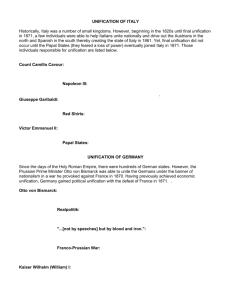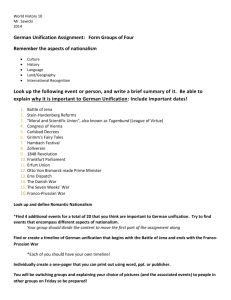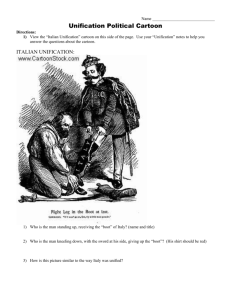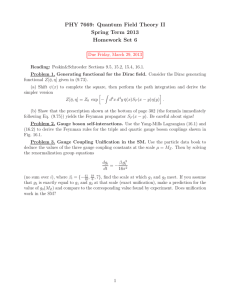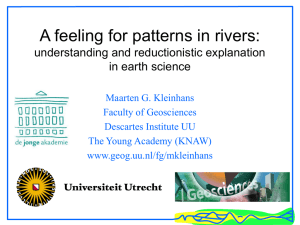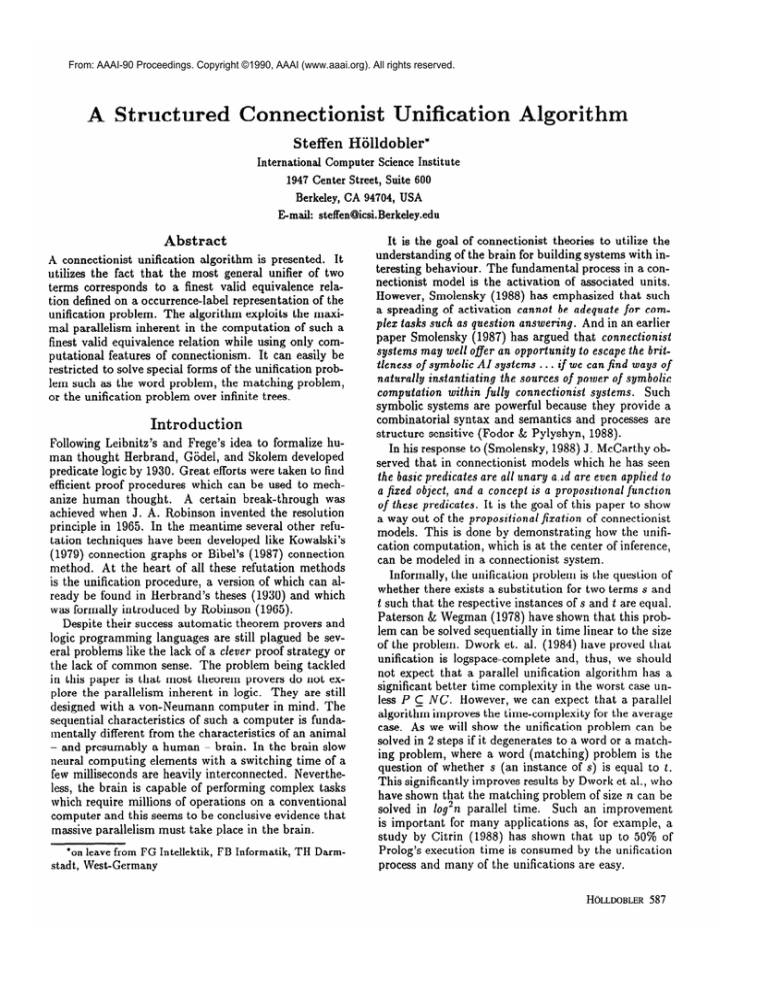
From: AAAI-90 Proceedings. Copyright ©1990, AAAI (www.aaai.org). All rights reserved.
A Structured
Connectionist
Unification
Algorithm
Steffen Hiilldobler*
International
Computer
Science Institute
1947 Center Street, Suite 600
Berkeley, CA 94704, USA
Ema&
steffenQicsi.Berkeley.edu
Abstract
A connectionist
unification
algorithm
is presented.
It
utilizes the fact that the most general unifier of two
terms corresponds
to a finest valid equivalence
relation defined on a occurrence-label
representation
of the
unification
problem.
The algorithm
exploits the maximal parallelism
inherent in the computation
of such a
finest valid equivalence
relation while using only computational
features of connectionism.
It can easily be
restricted to solve special forms of the unification
problem such as the word problem, the matching
problem,
or the unification
problem over infinite trees.
Introduction
Following Leibnitz’s and Frege’s idea to formalize human thought Herbrand,
Gijdel, and Skolem developed
predicate logic by 1930. Great efforts were taken to find
efficient proof procedures
which can be used to mechanize human thought . A certain break-through
was
achieved when J. A. Robinson invented the resolution
principle in 1965. In the meantime
several other refutation techniques
have been developed like Kowalski’s
(1979) connection
graphs or Bibel’s (1987) connection
method.
At the heart of all these refutation
methods
is the unification
procedure,
a version of which can already be found in Herbrand’s
theses (1930) and which
was formally introduced
by Robinson (1965).
Despite their success automatic
theorem provers and
logic programming
languages
are still plagued be several problems like the lack of a clever proof strategy or
the lack of common sense. The problem being tackled
in this paper is that most theorem provers do not explore the parallelism
inherent
in logic. They are still
designed with a von-Neumann
computer in mind. The
sequential characteristics
of such a computer is fundamentally different from the characteristics
of an animal
- and presumably
a human - brain. In the brain slow
neural computing
elements with a switching time of a
few milliseconds
are heavily interconnected.
Nevertheless, the brain is capable of performing
complex tasks
which require millions of operations
on a conventional
computer and this seems to be conclusive evidence that
massive parallelism
must take place in the brain.
*on leave from FG Intellektik,
stadt, West-Germany
FB Informatik,
TH Darm-
It is the goal of connectionist
theories to utilize the
understanding
of the brain for building systems with interesting behaviour.
The fundamental
process in a connectionist
model is the activation
of associated units.
However, Smolensky (1988) has emphasized
that such
a spreading of activation
cannot be adequate for complex tasks such as question answering.
And in an earlier
paper Smolensky (1987) h as argued that connectionist
systems may well offer an opportunity to escape the brittleness of symbolic AI systems . . . if we can find ways of
naturally instantiating the sources of power of symbolic
computation
within fully connectionist
systems.
Such
symbolic systems are powerful because they provide a
combinatorial
syntax and semantics
and processes are
structure sensitive (Fodor & Pylyshyn,
1988).
In his response to (Smolensky,
1988) J. McCarthy observed that in connectionist
models which he has seen
the basic predicates are all unary a.ld are even applied to
a fixed object, and a concept is a propositional function
of these predicates. It is the goal of this paper to show
a way out of the propositional fixation of connectionist
models. This is done by demonstrating
how the unification computation,
which is at the center of inference,
can be modeled in a connectionist
system.
Informally, the unification
problem is the question of
whether there exists a substitution
for two terms s and
t such that the respective instances of s and t are equal.
Paterson & Wegman (1978) have shown that this problem can be solved sequentially
in time linear to the size
of the problem. Dwork et. al. (1984) have proved that
unification
is logspace-complete
and, thus, we should
not expect that a parallel unification
algorithm
has a
significant better time complexity in the worst case unless P C NC. However, we can expect that a parallel
algorithm improves the time-complexity
for the average
case. As we will show the unification
problem can be
solved in 2 steps if it degenerates
to a word or a matching problem, where a word (matching)
problem is the
question of whether s (an instance of s) is equal to t.
This significantly
improves results by Dwork et al., who
have shown that the matching problem of size n can be
solved in log2n parallel time.
Such an improvement
is important
for many applications
as, for example, a
study by Citrin (1988) h as shown that up to 50% of
Prolog’s execution time is consumed by the unification
process and many of the unifications
are easy.
HOLLDOBLER
587
Distributed
unification algorithms such as the one developed by Vitter & Simons (1986) make use of a dug’representation
of the unification
problem.
The parallelism exploited by these algorithm has its source in the
decomposability
axioms which characterize
unification.
These axioms state that two terms f (si , . . . , sn) and
subterms
f@l,. . . , tn) are unifiable if all corresponding
s; and ti are unifiable.
The unifiability
of these subterms is determined
in parallel as far as this is possible.
Most of the approaches towards a connectionist
unification algorithm are parts of the design of larger inference systems.
Let us describe these approaches
as far
as unification
is concerned.
Ballard (1986) prewires all
substitutions
and selects a substitution
which is consistent with a refutation
proof. This is possible because
terms can only be variables and constants,
clauses are
used at most once and, thus, the set of substitutions
is
finite. Touretzky’s
& Hinton’s (1988) DCPS is capable
of matching a hypothesis of the form (zeb)(xcd)
against
the content of the working memory by searching for a
minimum
energy state, where x is a variable and the
remaining symbols are constants.
While it seems to be
possible to relax the constraints
on the occurrences
of
variables in the hypothesis
it is by no means obvious
how their technique
can be applied if n-ary function
symbols are allowed and if the elements of the working memory may also contain variables.
Mjolsness et
al. (1989) match a dag with variables against a dag
without variables by minimizing
an objective function,
which specifies the mismatch (or distance) between the
dags. However, it is not obvious that they always find
the most general solution and it seems to be impossible
to extend their approach in order to deal with unification problems.
Lange & Dyer (1989) and Ajjanagadde
SCShastri (1989) assign a unique signature or phase (of a
phased clock) to constants.
Dynamic bindings are created by passing these signatures
or phases.
However,
their systems do not guarantee
in general that multiple
occurrences of the same variable are bound to the same
constant.
It is also not easy to see how their proposals can be extended to cope with function embeddings
which arise during the unification process if n-ary function symbols are allowed.
The connectionist
approaches mentioned
so far have
severly shortcomings
as far as the unification
computation is concerned.
Only Stolcke (1989) has recently
investigated
unification
from a connectionist
point of
view. Stolcke represents
terms as dags and - inspired
by Paterson SC Wegman (1978) - defines an equivalence
relation on the nodes of a dag. He computes this relation via a connectionist
network by explicitely
coding
the axioms defining the equivalence relation.
However,
Stolcke’s algorithm
will unify the terms x and f(x),
since it does not check that the equivalence
relation is
acyclic or, in other words, it does not perform an occur
check. Furthermore,
the algorithm
does not compute
the most general unifier d for two terms s and t, but
‘directed
acyclic graph
588 KNOWLEDGEREPRESENTATION
the term CS. It is not obvious how the algorithm
can
be changed such that an occur check is performed and
the most general unifier is returned.
In this paper we present a connectionist
unification
algorithm.
Terms and substitutions
are represented
as
sets of occurrence-label
pairs. Using Smolensky’s (1987)
terminology
the occurrences
are the roles that are filled
by the labels. This representation
allows us to represent terms and substitutions
in a finite net though the
set of terms as well as the set of substitutions
is infinite. We define a finest valid equivalence
relation on
this representation,
which represents a solvable unification problem, and show how this relation can be computed using only simple threshold units. Moreover, we
formally prove that our connectionist
model solves the
unification
problem. On this way we solve the variable
binding problem and, moreover, ensure that multiple
occurrences of the same variable are consistently
bound
to the same term (see e. g. (Barnden,
1984)). Due to
lack of space we had to omit some details and all the
proofs. They can be found in (Holldobler,
1990). As
far as this paper is concerned
we do not address the
problem how the connectionist
net is recruited.
We expect that the unification
algorithm
will be built into a
larger system and that such a system will take care of
this problem.
The Unification Problem
We assume to have a finite alphabet consisting of a set
F of graded function symbols and a set V of variables.
Terms and substitutions
are defined as usual. Throughout the paper a, b, . . . denote function symbols, s, t, . . .
denote terms, and Z, y, . . . denote variables.
A unification problem consists of two terms s and t
and is denoted by (s = t). It is the problem of whether
there exists a substitution
0 such that crs = at. If such
a substitution
CTexists then c is called unifier of (s = t).
A substitution
c is said to be a most general unifier, or
mgu, for (s = t) iff for each unifier 0 for (s = t) there
exists a substitution
X such that for each variable x occurring in (s = t) we find 0x = Xax. It is well-known
that the unification
problem is decidable and that an
mgu of two terms can effectively be computed
whenever the terms are unifiable (Robinson,
1965). Such
an mgu is unique modulo variable renaming
(Fages 9c
Huet, 1986) and, therefore, is often called the mgu.
To develop a unification algorithm we need an axiomatization of unification
which is suitable for a connectionist implementation.
We will essentially
use Paterson’s & Wegman’s (1978) approach, but our algorithm
is not based on a dag but on an occurrence-label
representation of the unification
problem.
The set of occurrences of a term t, O(t), is inductively defined as A E O(t), and A E O(ti) implies i.7 E
O(f (tl, -- -9tit - - . , tn)) for all 1 5 i 5 n2. On occurrences a partial ordering is defined by ~1 2 a:! iff there
2We omit A and . if this does not lead to confusion.
exists a 7rz such that 11.7ra = x2. Furthermore,
1~1> 7r2
iff ~1 2 7r2 and 7ri # 72.
7r in
The set of labels, l(r), for each occurrence
the terms of a unification
problem (s = t) is the set
of symbols occurring
at 7 in s and t. The set l(n)
can be split into the disjoint subsets l!(r) and I”(A),
which contain the function symbols and‘ variables,‘ respectively.
For the unification
problem
(f (x, x, y) =
we obtain
f (9(Y)? 9(9(4), s(4))
2. (s = t) has a solution ifl there is a homogeneous
acyclic DSE-relation
on 0.
Moreover, Paterson’s
SC Wegman’s have shown that
the mgu of two terms can be constructed
from the finest
valid equivalence
relation on the set of occurrences
of
the unification
problem.
For our running example we
will briefly recall this technique.
[A] is the largest class4
(wrt +). But since [A] is not labelled by a variable we
can discard it. For the next class, [l, 21, we find - by
inspecting
the labels as well as the ordering + - that
x is bound to g(y) and we generate the binding {x 6
g(y)).
Similarly, for [ll, 21,3] and [211,31] we obtain
the bindings
{y + g(t)) and {z + a}, respectively.
Combining
these bindings yields
{% c
In the sequel let (s = t) be a unification
problem and
0 = O(S) U O(t). An equivalence relation N on 0 is
said to be
decomposable3ifT
Vq, 7~2E 0 : q - 7r2 E 0
A 3
homogeneous
singular
: (sl-i,
q-i)
C 0 *
x1-i cv 7r2.i,
iff Vq, 7r2E 0 : r1 N x2
iff h1,7r2
E 0 : 1,(7r~) n l,(n2)
# 0 j
xl N x2.
A decomposable
and singular equivalence
relation is
called DSE-relation.
We denote a w-equivalence
class
7r,J whenever { ~1,. . . , 7rn} C C. For NC by [v-,
equivalence
classes Ci and C2 we define Ci + C2 iff
there exist al E Ci and 7r2 E C2 such that ~1 > ~2.
An equivalence
relation m is said to be acyclic iff the
N-equivalence
classes are partially ordered by +. A homogeneous and acyclic DSE-relation
is said to be valid.
For (f(x, x, Y) = f (9(y), 9(9(4), s(a))) a valid equivalence relation
is defined by the equivalence
classes
[A] + [l, 21 + [ll, 21,3] + [211,31].
For (f(x, y) =
DSErelation
f MY), g(x))) th ere e.xists a homogeneous
with equivalence classes [1,21] and [11,2]. But this relation is cyclic. To gain efficiency the check whether
a DSErelation
is acyclic - also called occur check has been omitted
in virtually
all logic programming
systems.
Colmerauer
(1984) corrected this bug by interpreting
logic programs no longer over the Herbrand
universe or finite trees, but over the domain of infinite
trees. There, the latter problem is solvable by replacing
a~ as well as y by the infinite tree g(g(g(. . .))). Proposition 1 is an immediate
consequence
of (Paterson
SC
‘CVegman, 1978) and (MacQueen
et al., 1984).
and
Q, Y + SW, x c s(sb)>L
which is the mgu of the unification
problem.
Because
of this technique and since we regard our connectionist
unification
algorithm
as part of a larger inference system utilizing the same representation
as the unification
algorithm itself, we are satisfied if the connectionist
unification algorithm generates the finest valid equivalence
relation for a unification
problem.
A Connectionist Unification Algorithm
In the first step towards a connectionist
unification algorithm we use the fact that a DSErelation
can be characterized by its equivalence classes, which in turn can be
represented
by the union of the labels of its members.
As we show in the following subsection,
these unions
can be computed by two simple operations derived from
the axioms of decomposability
and singularity.
Thereafter we demonstrate
how the unification
problem can
be represented
and how the finest DSE-relation
can be
computed by a connectionist
model. It remains to be
checked that the finest DSE-relation
is homogeneous
and acyclic. This can be done by a simple extension of
the connectionist
model developed until then.
Representing
a DSE-Relation
Let w be a DSErelation
for a unification
problem
(s = t). For a w-equivalence
class C the set of labels,
l(C), is the union of the set of labels of its elements.
As
before, the set of labels of C can be split into the disjoint subsets Ii(C) and l,,(C) containing
the function
symbols and variables,
respectively.
As example consider (f (x, x,
Y) = f(9(Y),
9(9(z)),
s(4))
and we find
Proposition 1
1. (s = t) has a solution
over the domain of infinite
trees ifl there is Q homogeneous
DSE-relation
on 0.
3 Decomposability
is often called
(Dwork et al., 1984)) and sometimes
(e.g. (Kirchner, 1984)).
correspondence
(e.g.
Since we intend to represent
by l([x]) we have to generate
the m-equivalence
classes
I([x]). Let A contain the
implies homogeneity
‘called root class in (Paterson
& Wegman, 1978)
H~LLDOBLER
589
axioms of reflexivity, symmetry,
transitivity,
decomposability, and singularity.
By A l- ~1 - 7~ we denote that
~1 - 7~ can be derived from A. It can now be shown
that for ~1 # 7r2
At- 7r1 N r2 e3?r,~‘L,i~;
:
AI- n; ry ~5 Ax1 = n’,&br2
= +rAZ,([Qr$])
# 0
holds.
This tells us that, if 7~ and 7~ are in the
same DSE-equivalence
class, then either there is a variable among the labels of [al, 7r2] or we find occurrences
?r, $, ~5 such that r # A, ~1 = ?ri. P, 7r2 = ni - x, and
there is a variable among the labels of [tir, ti2]. In other
words, the finest DSE-relation
can be constructed
entirely from occurrences which are labelled with the same
variable. The key idea of the connectionist
unification
algorithm is to increase the set of labels of each occurrence 7r until Z(7r) = {([xl). When shall the set of labels
be increased?
By the singularity
of - we find that
whenever
Z&r)
n Zv(7r2)
# 0
and by the decomposability
of - and the previous
we find that
l(7rl .T) - Z(7rl .n) u Z(n2 4
whenever I, (~1) n 1,(7r2)# 0
(ups)
result
(0~)
where + denotes assignment
and A # A. In the sequel we show that these two operations
can easily be
performed by a connectionist
model and that they generate indeed the finest DSErelation.
Representating
a Unification
Problem
The unification
algorithm is based on Feldman’s 9c Ballard’s (1982) connectionist
model.
Units are charcterized by a potential p, an output value v, and a vector of inputs il, . . .,2n.
*
In particular
we use so-called
threshold units, whose potential
and output values are
determined
via the rules
c
Wkik,
Pv+ifp>othen
lelse0,
where 0 is a constant
called threshold and Wk are
weights on the input values. The unique output value
is spread along all connections
from the unit though
these connections
are not always drawn from the same
location. For convenience
we occasionally
use a bidirectional link + with weight w between two units ~1 and
T.L~as an abbreviation
for two links with weight w; one
from ui to 112 and another one from ~2 to ui.
The sets of labels for a unification problem can be represented by threshold units M(n, j) for each occurrence
a and each symbol j such that M(n, j) is active iff j is
a label of r. A unification
problem is specified by externally activating
the units which define the problem.
This external activation
has to be maintained
throughout the computation
since threshold units do not memorize their potential.
For our running example we obtain
the units depicted in figure l(a) as a matrix. One should
observe that this representation
is not unique. The unification problem (f(x, s(s(+,
Y) = f(g(& 2, d-4)) 1~
590 KNOWLEDGEREP~SE~ATION
afg
xyz
fl 0~0000
1 ooe~oo
11 0000~0
2 001)QOO
21 00~000
21100000e
3 ooeoao
31 a00000
afg
xyz
0a0000
oo~eoo
ooooeo
ooamoo
oo1)ooo
oooooe
oo*ooo
00 000
w
afg
xyz
0e0000
001) a00
000 oeo
oomQOO
0000ao
00000a
009 000
a00 000
(4
Figure
1:
The
representation
of (j(x, Z,U)
=
f(g(y), g(&)),
g(a))); (a) initially, (b) after 1 step, and
(c) after 2 steps, where the most recently activated units
are half-filled.
the same representation
as the running example.
But
this does not lead to a problem since the finest valid
equivalence relation is identical for both examples.
If we update the labels according to the operations
ops and OpD we obtain figures l(b) and l(c) after 1
and 2 steps, respectively.
For example, since M(11, y),
are active in (a), M(ll,g)
has
q3,
!I), and M(3,g)
M(2, z),
become active in (b) by ops. Since M(l,x),
and M(ll, y) are active in (a), M(21,y)
has become
active in (b) by OpD. The final matrix in (c) represents
precisely the labels of the finest DSErelation
and is
considered as the output of our unification
algorithm.
How must a connectionist
network look like in order
to implement
the operations
ops and OpD? We propose a network consisting of two layers called term and
unification
layer.
Let n = IO(s) U O(t)1 be the size
of the alphabet,
and
of (s = t), m be the cardinality
w = imn(n-1)
be an integer used to set up thresholds
and weights.
The term layer contains the representation
for a unification problem as an nxm matrix A4 of threshold units
with threshold w. Each unit is connected
via bidirectional links with n-l
units in the unification
layer and
has weight w. The unification layer contains the units
necessary to implement
ops and OpD. For both operations the algorithm has to determine
whether two occurrences share a common variable and to update sets
of labels accordingly.
This requires that for any two occurrences rri and 7r2 and for any symbol j, M(K~, j) and
M(n2,j)
are connected.
Since the unification
problem
has n different occurrences
and m different symbols, we
need in(n1) units for each symbol, i.e. altogether
w
units. These units can be represented
by a Ln(n-1)xm
matrix U of threshold units with thresh01 3 w+l.
An
element of this matrix is denoted by U( { ~1,7rz}, j), or
that this unit is conU(ri, 7r2, j) for shorts, indicating
nected with itl(ni, j) and M(az, j). Each unification
layer unit is also connected
to other unification
layer
units with weight 1 such that there is a connection from
5Note,
I/( A~, ~2, j) and U( x2, ~1, i) denote the same unit.
for all z E V, j E VU F, j # x, and
U(rr, x2,2) to U(?rr .x, 1r2’1r,j) for all 7r # A, x E V,
j E V U F such that {WI SW,7r2.7r) C O(s) U O(t).
The threshold of a unification
layer unit is chosen such
that active unification
layer units can only activate another unification
layer unit if this unit receives also activation from the term layer. Conversely, a term layer
unit is activated as soon as a corresponding
unification
layer unit is active. To exemplify the network figure 2
shows the term layer together with the unification
layer
units and the connections
needed to solve our running
example.
All externally
activated term layer units are
represented
as full circles. The interested
reader is encouraged to verify that the number i in a unit indicates
that this unit will be activated after i steps.
a
f
g
X
Y
z
Figure 2: The cyclic term layer together with the triangular unification layer units and the connections
needed
for solving (f(x, 2, y) = f(!J(Y)Y s(sW,
g(4)).
Recall
that a unification
layer unit U(K~, 7r2, j) is uniquely determined by its term layer units M(R~, j) and M(.Rz, j).
Each connection
between
unification
layer units has
weight 1 and each connections
between a unification
and a term layer unit has weight w.
Computing
the finest
DSE-relation
1Ve are of course interested in whether the connectionist
model computes the finest DSErelation
for any solvable
unification
problem. To answer this question we define
a function T on the units of the term and unification
layer. Let N be a set of term and unification
layer units
in T(N) = N U Tl(N) U Tz(N), where
Tl(N)
= {M(s,
j) 1%’ : U(r,
x’, j) E N}
G(N)
= {U(n,mj)
1 {M(mj),M(mj))
S N
v [(M(v,j)
E N V M(n,j)
E N) A D(wI, ~2, N)]}
D(al, r2, N) = 3x E v : 37r,n;, 7: : Rl =7r I *?r
A a2 = +iT Au(&a$,&
N.
By the definition of T and the fact that there are only
finitely many units we find that
T(N)
T(N)
2 N,
= N implies
T’(N)
= ,V for all i > 0, and
3k:Tk+'(N)= Tk(N).
In fact, we can show that X: is bounded by the number
n of occurrences
in a unification
problem.
Now let N
be the set of active term layer units which represent
a ‘unification problem and let .V* = Tk(N) such that
T(N*) = N”. The interested
reader may check that for
our running example N* = T6 (,V). We can now answer
the question raised at the beginning
of this subsection.
Theorem 2
‘dx~O:Vj~VuF:M(n,j)~N”ej~/([lr]).
This result ensures that a finest DSE-relation
for a
unification
problem is generated
by the connectionist
model. That it is indeed the finest DSErelation
follows immediately
from the fact that each activation
was forced by either the axiom of singularity
or the axiom of decomposability.
The space complexity is bound
problem,
by the square of the size n of the unification
whereas the time complexity
is bound by n, We should
not be disappointed
by these results as Dwork et al.
(1984) have proved that unification
is logspace complete.
But look at a best case scenario.
This is the
case if the unification
problem degenerates
to a word
problem, i.e. to the question
of whether two terms s
and t are syntactically
equal.
If the word problem is
solvable, then the finest DSE-relation
is found after 1
step. Similarly,
we can show that even for a matching problem, i.e. the problem of whether there exists a
substitution
c for s and t such that 0s = t, the finest
DSErelation
is also found after 1 step. As an example
consider s = f(x, s(x)) and t = f@(a), g(W)))Then,
N
=
and T(N)
{WA, f>, Wl, 4, -M(l, h), M(W-4,
M(b),
M(21, xc), Au(21, h), Af(211,
as well as T2(N)
N u {U(1,21,h),
are equal to
U(11,211,u),U(1,21,x)}.
Hence, the matching problem
eral solution { 2 + h(u)}.
Homogeneous
a)}
is solvable
with most gen-
DSE-relations
A DSErelation
need not to be homogeneous.
This can
be seen if we alter our running
example by replacing
the z by a new constant b. The finest DSErelation
for
(f(x,
2, Y) = m(Y)9
g(g(b)),
SW)
can be computed
as
before and we find that 211 - 31 and 11([211,31]) =
iff we find
b-d).
H owever , since - is homogeneous
for all 7r that I1f([r])l 5 1, we conclude that - is not
homogenous iff there is a row rr in the term layer and at
least two function symbols fr and f2 such that M(x, fl)
and M(x, f2) are active. This condition can be directly
translated
into a connectionist
network.
For each row
7r of the term layer we insert an additional
threshold
HOLLDOBLER
591
unit which receives activation
from each unit M(r, f),
where f is a function symbol, and becomes active as
soon as it is excited by two term layer units.
Proposition
l( 1) ensures that the algorithm
developed so far decides a unification
problem over infinite
trees. One should observe, that the matching problem
is the same regardless
whether it is interpreted
over
the domain of finite or infinite trees. Thus, we find
that whenever T2(N) > T(N) the matching problem is
unsolvable and, hence, a matching problem can be decided in 2 steps. This improves a result by Dwork et al.
(1984), who have shown that the matching problem of
size n can be solved on a PRAM in Zog2n parallel time.
Valid
Equivalence
c\
{C(?rlJ',)
1 GlC(iT&)
k3
w
(4
Figure 3: (a) the term layer representing
the finest DSErelation and (b) the occur check layer for (f(x, y) =
&w
With this definition
we find
S(C)E c
S(C)
= C 3 Vk 2 0 : Sk(C)
3k 5 n : Sk+l(C)
= C and
= Sk(C)
Now let C = {C(n, x’) 1 ?r - R’} and C” = Sk(C) such
that S(C*) = C*. In other words, C contains all occur
check layer units which are initially active.
Theorem
3 C” = 8 i$ -
is acyclic.
It remains to show how the occur check layer units
are initially activated.
Therefore,
assume that all occur check layer units are externally
inhibited.
Such an
inhibition
of a unit C(rl, ~‘1) is blocked and the unit
is excited iff there is an active unification
layer unit of
the form U(n2, ?r& x) and an occurrence
x such that
and n{ = R$?T, where x is a variable. Notice
Tl = 7r2.7rT,
that a unit has to be excited only once whereas the inhibition has to be blocked for the time the occur check
layer needs to settle down.
Discussion
We have presented a connectionist
unification algorithm
and shown that it is correct and complete.
The algorithm does not propagate
potential
non-unifiability
as
Stolcke’s (1989) algorithm
does.
This propagation
is
vital for Stolcke’s approach since his algorithm
is initialized by activating
the unit which represents the fact
that the unification
problem is solvable. We have tried
to add the propagation
of potential
non-unifiability
to
our unification
algorithm
but all examples suggested
that there will be no considerable
speedup.
Recall that an equivalence
relation on a set of occurrences is homogeneous
iff each occurrence is labelled
with at most one Function symbol. Consequently,
if the
equivalence relation is homogeneous,
then in each row of
the term layer there is at most one of the units active
which represent
the function symbols.
In this special
case a coarse coded representation
of the function symbols is possible even without any cross-talk.
E c:
C(Al,k/l) < c(;r2,7r9}6.
592 KNOWLEDGEREPRESENTATION
el
21
f(gb),
Relations
It remains to be checked whether the finest homogeneous DSE-relation
is acyclic or, in other words, valid.
Unfortunately,
there is no unit in our connectionist
model which represents
a w-equivalence
class. However, we know that two different occurrences ~1 and r/1
are equal under - iff there are a variable x and occurrences 7r2, irk, and 7r such that U(n2, K$, x) is active,
This fact will be exploited in
Kl = r2.7r, and sri = +r.
order to determine whether - is acyclic in an additional
layer of our algorithm
called occur check layer. This
layer consists of $z(n - 1) threshold units C( {n, n’)) or C(n, R’) for short - with threshold 1, where 7r # ?r’.
Let C(B~, n{) > C(Q, &J iff there exist x E { ~1, a{}
and 7 E (x2, ni} such that I > 7. The units in the
occur check layer are connected by links with weight 1
from C(7r1, ai) to C(a2,7r$) iff C(nl, 7r{) > C(7r2,7rr/2).
Now assume that each element C(n, a’) is initially activated if 7r - x’, whereas C(r, a’) is externally inhibited
if A + r’. This inhibition
must’be strong enough such
that an occur check layer unit cannot be activated by
other occur check layer units.
As a result units rep:
resenting a cycle will form a stable coalition, whereas
units which are not part of a cycle will be deactivated
after some time.
As an example
consider (f(x, y) = f(g(y),g(x))).
A homogeneous
DSE-relation
exists and is depicted
in figure 3(a).
Since 1 - 21 and 2 - 11 the units
will initially
be active.
C(1,21)
and C(2,ll)
Figure 3(b) shows the occur check layer, where all connections
to and from a self-excitatory
unit are not
drawn.
The units C(l,21)
and C(2,ll)
are mutually
excitatory
and form a stable coalition.
Notice that
C(21,ll)
is externally
inhibited
and,‘thus,
cannot be
activated
by C( 1,21) and C(2,ll).
For our running
example (f(x,x, y) = fMY), !l(!l(4), !lW)) the units
C(l, 2), C( 11,21), C(ll, 3), C(21,3), and C(211,31) are
initially active, but are all deactivated
after 3 steps.
The behaviour
of the occur check layer can be forLet C be a set of active occur check
mally verified.
layer units and S be a transformation
on C such that
S(C)=
2
6C \ C’ denote the set C minus the set C’.
What is this unification
algorithm
good for besides
showing that unification
can be implemented
in a connectionist
system ? We would like to apply it within
term rewriting, logic programming,
or theorem proving
in order to tackle the problems mentioned
in the introduction.
But there are a lot of open problems.
We
have assumed that all units of our layered architecture
are prewired. This is all right as long as the application
requires only a bounded number of clauses. If, however,
an unbounded
number of variants of clauses is needed,
then the network has to be recruited dynamically.
The
unification
problem admits a single solution.
Unfortunately, as soon as we are interested in unification
under
certain equational
theories, we have to deal with complete sets of unifiers. These sets may be even infinite.
Similarly, a problem posed to a theorem prover may
admit several solutions.
How can we represent multiple
solutions and how can we deal with potentially
infinite
computations
in a connectionist
theory?
Acknowledgement:
I would like to thank Jerry Feldman for his guidance and support as well as Andreas
Stolcke and Heinz Schmidt, whose comments on earlier
versions of the unification
algorithm helped to improve
it considerably.
Lange, T. E. & Dyer, M. G. (1989). Frame Selection
in a Connectionist
Model of High-Level Inferencing. In Proceedings of the Annual Conference
of
the Cognitive Science Society, pp. 706-713.
References
MacQueen,
D., Plotkin, G. D., & Sethi, R. (1984). An
Ideal Model for Recursive Polymorphic
Types. In
Ajjanagadde,
V. & Shastri, L. (1989). Efficient Inference with Multi-Place
Predicates
and Variables in
a Connectionist
System. In Proceedings of 2he Annual Conference
of the Cognitive
Science
Society,
pp. 396-403.
P arallel Logic Inference and EnIn Proceedings of the AAAI
Conference
on Artificial Intelligence,
pp.
Ballard, D. H. (1986).
ergy Minimization.
National
203 - 208.
Barnden,
J. A. (1984).
On Short Term Information
Processing
in Connectionist
Theories.
Cognition
and Brain
Theory,
7:25-59.
Bibel, W. (1987). A u t omated Theorem Proving.
Verlag, Braunschweig,
second edition.
Vieweg
Citrin, W. V. (1988). Parallel Unification
Scheduling
in Prolog.
Technical
Report UCB/CSD
88/415,
University of California,
Berkeley.
Colmerauer,
A. (1984). Equations
and Inequations
on
Finite and Infinite Trees. In Proceedings of the International
Conference
on Fifth
puter Systems, pp. 85-99.
Generation
Com-
Dwork, C., Kannelakis,
On the Sequential
P. C., SC Mitchell, J. C. (1984).
Nature of Unification.
Journal
of Logic Programming,
1:35-50.
Fages, F. & Huet, G. (1986). Complete Sets of Unifiers
Journal of
and Matchers in Equational
Theories.
Theoretical Computer Science, 43:189-200.
Feldman, J. A. SC Ballard, D. 1~. (1982). Connectionist
Models and Their Properties.
Cognitive Science,
6(3):205-254.
Fodor, J. A. SC Pylyshyn, Z. W. (1988). Connectionism
and Cognitive Architecture:
A Critical Analysis. In
Pinker &z Mehler, eds., Connections
and Symbols,
pp. 3-71. MIT Press.
Herbrand,
J. (1930). Sur la Theorie de la Demonstration.
In Goldfarb,
ed., Logical Writings (1971).
Cambridge.
HSlldobler, S. (1990). A C onnectionist
Unification
Algorithm.
Technical
Report TR-90-012,
International Computer
Science Institute,
Berkeley, California.
Kirchner,
C. (1984).
A New Equational
Unification
Method: A Generalisation
of Martelli-Montanari’s
Algorithm.
In Proceedings
of the Conference
on
Automated Deduction, pp. 224-247.
Kowalski, R. (1979). Logic for Problem Solving,
of Artificial Intelligence.
North Holland,
York/Oxford.
Proceedings of the ACM Symposium
of Programming
Languages.
vol. 7
New
on Principles
Mjolsness, E., Gindi, G., St Anandan,
P. (1989). Optimization in Model Matching and Perceptual OrgaNeural Computation,
1:218-229.
nization.
Paterson, M. S. SCWegman, M. N. (1978). Linear Unification. Journal of Computer and System Sciences,
16:158-167.
Robinson, J. A. (1965). A machine-oriented
on the resolution
principle.
Journal
12:23-41.
logic based
of the ACM,
Smolensky,
P. (1987).
On Variable Binding and the
Representation
of Symbolic Structures
in Connectionist Systems.
Technical Report CU-CS-355-87,
Department
of Computer
Science 9c Institute
of
Cognitive Science, University
of Colorado.
Smolensky, P. (1988). On the Proper Treatment
of Connectionism.
Behavioral and Brain Sciences,
1 l:l74.
Stolcke, A. (1989). Unification
as Constraint
Satisfaction in Structured
Connectionist
Networks. Neural
Computation,
1(4):559 - 567.
Touretzky, D. S. St Hinton, G. E. (1988). A Distributed
Connectionist
Production
System.
Cognitive Science, 12:423 - 466.
Vitter, J. S. & Simons, R. A. (1986). New Classes for
Parallel Complexity:
A Study of Unification
and
other complete Problems for P. IEEE Transactions
on Computers,
pp. 403-418.
H~LLDOBLER
593


